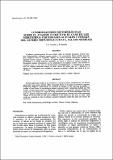Por favor, use este identificador para citar o enlazar a este item:
http://hdl.handle.net/10261/23183COMPARTIR / EXPORTAR:
 SHARE SHARE
 CORE
BASE CORE
BASE
|
|
| Visualizar otros formatos: MARC | Dublin Core | RDF | ORE | MODS | METS | DIDL | DATACITE | |

| Campo DC | Valor | Lengua/Idioma |
|---|---|---|
| dc.contributor.author | González-Fernández, José E. | - |
| dc.contributor.author | Sanchiz, Borja | - |
| dc.date.accessioned | 2010-04-16T08:17:56Z | - |
| dc.date.available | 2010-04-16T08:17:56Z | - |
| dc.date.issued | 1986-12-30 | - |
| dc.identifier.citation | Estudios Geológicos 42(6): 479-486 (1986) | en_US |
| dc.identifier.issn | 0367-0449 | - |
| dc.identifier.uri | http://hdl.handle.net/10261/23183 | - |
| dc.description | 8 páginas, 6 figuras, 3 tablas. | en_US |
| dc.description.abstract | [ES] Se infieren cuantitativamente diversos modelos sobre la evolución del género Triturus (Caudata, Salamandridae), utilizando especies actuales y los representantes fósiles medibles más antiguos (Oligoceno basal de Hoogbutsel, Bélgica). Se obtienen diversas estimaciones variando los siguientes factores iniciales: a) número de especies fósiles; b) fórmula de cálculo de semejanza morfológica, y e) unidad anatómica esquelética. Se discute el número de especies presentes en Hoogbutsel mediante comparación con la variabilidad de las especies actuales. Estos modelos se comparan entre sí y con otros no fundamentados morfológicamente. La discrepancia es general entre las distintas inferencias, aunque es menor dentro del primer caso (a) y máxima en el segundo (b). Conjugando estos resultados se presenta un modelo evolutivo que integra a los restos fósiles. | en_US |
| dc.description.abstract | [EN] Several multivariate models of the evolution of Triturus (Caudata, Salamandridae)are inferred using both living species and the oldest measurable fossils of the genus (Lowermost Oligocene, Hoogbytsel, Belgium). Dendrograms are obtained by changes on the following parameters: a) number of fossil forms; b) morphological distance estimation; and c) anatomical skeletal unit. The number of fossil species present at Hoogbutsed is discussed by comparison with the variability of living forms. The models are compared among themselves and with non-morphological ones. The lack of a perfect congruence seems to be a general phenomenon, although less evident concerming changes in the first case (a) and more conspicous in the second (b) and (c) cases. These results are combined in order to estimate a general evolutionary model that takes into account the fossil forms. | en_US |
| dc.format.extent | 2204855 bytes | - |
| dc.format.mimetype | application/pdf | - |
| dc.language.iso | spa | en_US |
| dc.publisher | Consejo Superior de Investigaciones Científicas (España) | en_US |
| dc.rights | openAccess | en_US |
| dc.subject | Biosistemática | en_US |
| dc.subject | Metodología | en_US |
| dc.subject | Evolución | en_US |
| dc.subject | Triturus | en_US |
| dc.subject | Caudata | en_US |
| dc.subject | Oligoceno | en_US |
| dc.subject | Biosiystematics | en_US |
| dc.subject | Methodology | en_US |
| dc.subject | Evolution | en_US |
| dc.subject | Triturus | en_US |
| dc.subject | Caudata | en_US |
| dc.subject | Oligocene | en_US |
| dc.title | Consideraciones metodológicas sobre el análisis evolutivo: el caso de los morfotipos vertebrales actuales y fósiles del género Triturus (Caudata, Salamandridae) | en_US |
| dc.type | artículo | en_US |
| dc.identifier.doi | 10.3989/egeol.86426783 | - |
| dc.description.peerreviewed | Peer reviewed | en_US |
| dc.relation.publisherversion | http://dx.doi.org/10.3989/egeol.86426783 | en_US |
| dc.identifier.e-issn | 1988-3250 | - |
| dc.type.coar | http://purl.org/coar/resource_type/c_6501 | es_ES |
| item.openairetype | artículo | - |
| item.grantfulltext | open | - |
| item.cerifentitytype | Publications | - |
| item.openairecristype | http://purl.org/coar/resource_type/c_18cf | - |
| item.fulltext | With Fulltext | - |
| item.languageiso639-1 | es | - |
| Aparece en las colecciones: | (MNCN) Artículos | |
Ficheros en este ítem:
| Fichero | Descripción | Tamaño | Formato | |
|---|---|---|---|---|
| 809_002.pdf | 2,15 MB | Adobe PDF |  Visualizar/Abrir |
CORE Recommender
Page view(s)
384
checked on 22-abr-2024
Download(s)
245
checked on 22-abr-2024
Google ScholarTM
Check
Altmetric
Altmetric
NOTA: Los ítems de Digital.CSIC están protegidos por copyright, con todos los derechos reservados, a menos que se indique lo contrario.
